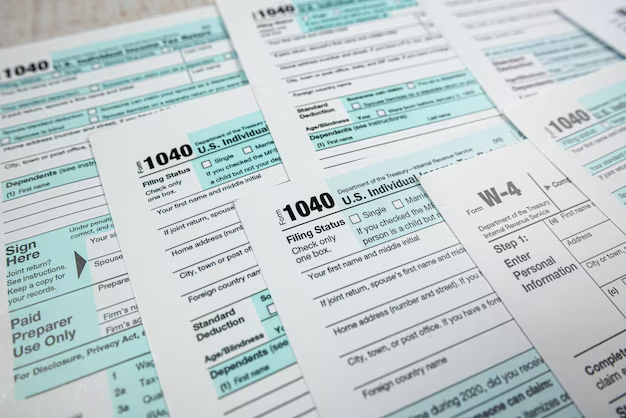Understanding the 1040 Form: Your Essential Guide to Filing Taxes
When tax season rolls around, one of the most critical documents you need to understand is the 1040 Form. For many Americans, it’s the cornerstone of the annual tax-filing ritual. But what exactly is this form, and why is it so important? Whether you’re a seasoned filer or new to the tax scene, understanding the 1040 Form is crucial for ensuring you meet your tax obligations accurately. This comprehensive guide will explore everything you need to know about the 1040 Form, making the process as stress-free as possible.
📄 What is a 1040 Form?
The 1040 Form is the standard IRS form used by individuals to file their annual income tax returns. It's a detailed document where taxpayers report their income, claim deductions and credits, and determine any taxes owed or refunds due. The form is designed to provide a complete picture of your financial year to the IRS.
Key Features of the 1040 Form
- Income Reporting: All sources of income must be reported, including wages, dividends, interest, and other earnings.
- Deductions and Credits: Taxpayers can claim deductions (like student loan interest) and credits (such as the Child Tax Credit) to reduce taxable income.
- Calculation of Taxes Owed or Refunds: The form helps determine if you owe additional taxes or if you are eligible for a refund.
🛣️ Who Should Use the 1040 Form?
Almost every U.S. taxpayer will use some version of the 1040 Form to file their taxes. However, the complexity of the form required can vary based on individual tax situations.
Different Versions of the 1040 Form
- Form 1040-SR: Tailored for senior taxpayers aged 65 and older, providing a simplified process for common income types for seniors.
- Form 1040-NR: Used by non-resident aliens to report their U.S. income, applicable for those who receive income from U.S. sources but are not U.S. citizens or residents.
- Form 1040-X: This amended return form is necessary if you discover a mistake on previously filed taxes and need to address it.
🏗️ How to File a 1040 Form
Filing a 1040 Form can seem daunting, but breaking the process into steps can simplify it. Here’s a step-by-step guide:
- Gather Your Documents: Collect all necessary documents—W-2s, 1099s, and receipts for deductible expenses.
- Choose a Filing Method: Decide whether to file electronically using tax software or manually by mailing a physical form.
- Complete the Form: Follow the instructions carefully to fill out each section accurately.
- Double-Check for Errors: Review all information to avoid common mistakes, such as incorrect SSNs or calculations.
- Submit Your Form: File your completed 1040 by the deadline, typically April 15, unless the IRS grants an extension.
💡 Common Sections Explained
Understanding specific sections of the 1040 can help make sure you fill it out correctly.
Personal Information
Include your full name, Social Security Number, and filing status (single, married, etc.).
Income
Report all forms of income you received during the year, and ensure you include all relevant documents such as W-2s and 1099s.
Deductions
Optionally, choose between the standard deduction or itemizing deductions to reduce your taxable income. The standard deduction is fixed and varies depending on your filing status, while itemizing requires listing each deductible expense, such as medical costs and mortgage interest.
Tax Credits
Claim eligible tax credits which directly reduce the amount of tax owed. These could include the Earned Income Tax Credit or educational credits like the American Opportunity Credit.
Refunds or Amount Owed
Calculate whether you will receive a refund or still owe taxes. It's crucial to provide accurate banking details if expecting a refund via direct deposit.
🎯 Notable Points to Remember
Filing Deadlines
The typical tax filing deadline is April 15, but it's essential to check for changes or extensions specific to your filing year.
Extensions
If you need more time, consider filing for an extension, which can give you up to six extra months to submit your form, though any taxes owed are still due by the original deadline.
E-Filing Advantages
Electronic filing is faster and can lead to quicker refunds compared to mailing physical forms. Additionally, e-filing usually results in fewer errors due to software checks.
❗Summary of Key Takeaways
Here’s a quick summary to reinforce crucial points about the 1040 Form filing process:
- 👤 Know Your 1040 Version: Select the correct 1040 form based on personal circumstances.
- 📑 Document Readiness: Gather all relevant income documents ahead of time.
- 🗓️ Be Deadline-Aware: Keep an eye on deadlines and file for extensions if necessary.
- 🔍 Review with Care: Double-check for accuracy; errors can delay processing and refunds.
- 💻 E-File for Efficiency: Consider e-filing for quicker processing and fewer mistakes.
📚 Final Thoughts
Understanding the 1040 Form and its nuances can greatly reduce the stress often associated with tax filing. While the process might seem complex, breaking it down into manageable parts ensures you don’t miss out on deductions and credits. Equip yourself with the necessary information, and confidently navigate your tax filing this year. Happy filing!
